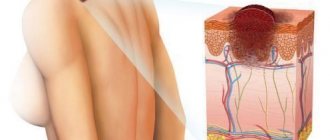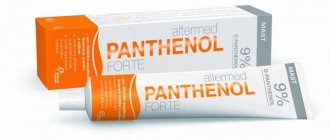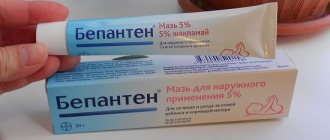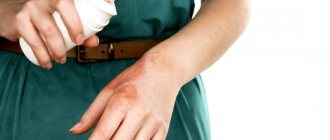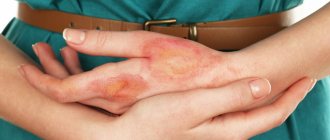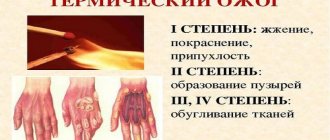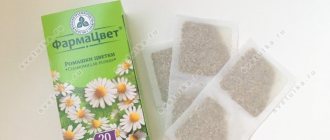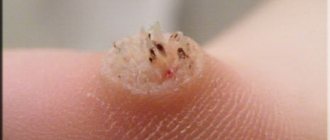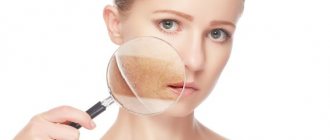What is a burn?
A burn is tissue damage caused by various reagents or high temperatures. The longer they act, the deeper the skin is affected and the more severe the symptoms.
Thermal factors that lead to burns can be steam, flame, hot objects, molten metals and hot liquids. Severe consequences remain after damage from hot objects, especially metals. Such damage affects deep tissues. The smallest area covers burns that occur when hot liquids come into contact with the skin. The lesions occupy a large area in pairs, but they are the least deep.
Exposure to flames is also dangerous for the life of the victim, since the body can be infected by the remains of clothing. In addition, the upper respiratory tract and eyes are affected.
Among chemical preparations, burn injuries are caused by acids, alkalis and heavy metals. Acids act on the superficial balls of the skin. With increasing acid concentration, their penetration into the skin will decrease. The victim quickly forms a scab, preventing further penetration of the acid. Alkalies penetrate much deeper, since such a barrier does not arise as a result of their influence. Heavy metals affect only the superficial layers of the skin. In appearance, such a burn resembles the effects of acid.
Electrical damage is also distinguished, which is characterized by the presence of entry and exit points of electric current. Such lesions occupy a small area but damage deep tissues.
Burns resulting from exposure to ionizing radiation pose a danger to the patient, since this causes the blood vessels to lose strength. Such injuries are characterized by prolonged bleeding and decreased ability to regenerate.
The larger the area of skin affected by the burn, the more difficult the patient’s recovery.
Prevention of thermal burns
- There should be fire extinguishers and smoke detectors in the house
- Make sure the fire alarm is loud enough (so it can wake up a sleeping child).
- Conduct an evacuation rehearsal
once .
- Teach children basic fire safety rules (“matches are not a toy”, “in case of a fire, call such and such a phone”, etc. ) .
- Don't wear a baby and something hot at the same time.
- Do not smoke, drink hot drinks or eat hot foods while holding a child.
- In general, don’t smoke in the house; and where you smoke, put out what you smoked.
- Do not hold your baby while preparing food.
- in the correct sequence and teach your child this: first the cold water tap, then the hot one.
- Never place pans on the front burners if the rear burners are free
.
- Make sure that the handles of pans and pots are turned towards the wall.
- Do not place dishes containing hot liquids or food on the edge of the table.
- Do not allow children to pour boiling water themselves.
- Take special care with sliding tablecloths, the edges of which could be pulled by a child; use non-slip mats instead of a tablecloth or at least napkins that do not protrude over the edge of the table.
- Keep sweets away from the stove.
- Particular attention should be paid to the electric kettle cord (so that a child cannot pull it). All cords should be kept as short as possible
.
- The kitchen is not a place for games or a place where a child can be unattended
.
- Do not leave your child alone where there is a source of open fire - a candle, fireplace, gas stove, fire
.
- Matches, candles, lighters, hot and flammable liquids are out of children's reach
.
- The iron is far (high), on a stable surface, optimally in a room where there are no children
.
- The iron is the
same attitude applies to everything hot: hair curlers, any heaters, steam humidifier , etc.
- Check (taste) the temperature of food and drinks you give to children
.
- Remember that microwave ovens do not heat food evenly. Take your time. Try it. Mix foods before giving to your child. Do not allow children to use microwave ovens on their own.
.
- Check the temperature of the water in which you are going to bathe your child.
.
- Do not pour flammable liquids into the fire, especially when there are children nearby (so that they are not tempted to repeat your nonsense)
.
- Don't throw empty cans into the fire
.
- Firecrackers, fireworks, fireworks, etc. - these are adults (!), not children's toys
).
- Remember: the “therapeutic” procedure called “soaring legs
”
is sadism and a crime
.
- Install protective fences (barriers) around everything that burns and heats up: stoves, fireplaces, fires, heaters, radiators , etc.
(This publication is a fragment of the book by E. O. Komarovsky “Handbook of Sensible Parents. Part 2. Emergency Care” adapted to the format of the article.)
Degrees of burns
Treatment is selected taking into account the degree. There are four of them:
- A first degree burn is limited to redness at the site of the injury.
- In the second degree, bubbles with liquid contents appear at the site of damage.
- A third degree burn affects all areas of the skin and subsequently causes necrosis of the affected area.
- In the fourth degree, tissue charring is observed.
Burn injury typically develops symptoms gradually. The pathology receives clear contours the next day.
1st degree burn
A 1st degree burn is diagnosed when the injury is limited to the area of the epidermis, the cells of which are quickly replaced. At the same time, blood circulation in neighboring areas remains virtually unchanged, which speeds up recovery.
Its reasons are:
The main symptoms of this category of burns are:
- skin redness;
- burning sensation;
- skin tightening;
- soreness.
In some cases, the patient experiences tissue swelling, but it is mild. The damaged area of skin is first dried and then exfoliated.
Since the skin is only slightly damaged at this level, the patient does not require special assistance. In cases of such damage, it is recommended to use agents that accelerate regeneration and relieve inflammation. For severe pain, it is better to use them in spray form. Such damage heals on its own within 10 days. There are no scars or scars left on the victim’s skin.
2nd degree burn
This is the most common degree. Its main symptom is the formation of blisters with yellowish contents on damaged skin. When they burst, the wound can become infected. After such damage, scars and scars may remain. There is noticeable redness and swelling of the skin around the affected area. A 2nd degree burn is accompanied by a burning pain that intensifies at the moment of touch. It is pain that is the distinguishing symptom from a 3rd degree burn, while the external manifestations are the same.
The main difference from a 1st degree burn is that in addition to the epidermis, the dermis is also damaged, down to the papillary layer. With a 2nd degree burn, microcirculation is disrupted in the damaged area and adjacent areas. However, the treatment is still successful, since the capillaries with nerves remain unaffected.
If the burn covers a wide area, there is a risk of infection and dehydration. In this case, the patient is prescribed antibiotics and infusions. If there are indications, an operation is performed to open the blisters and remove the fluid accumulated in them.
A second degree burn takes about 15 days to heal.
- apply antiseptic or antibacterial ointment to the affected area;
- applying an aseptic bandage on top, which prevents infection.
3rd degree burn
With third degree burns, the deep balls of the dermis are affected. In this case, microcirculation is disrupted. The skin is damaged down to the level of subcutaneous fat and is usually not capable of recovery. As a rule, a large surface of the skin is damaged, as a result of which the patient may develop a burn disease.
There are two subtypes of 3rd degree burns. When the sebaceous glands and hair follicles remain intact, a grade 3a burn is diagnosed. Bubbles with bloody fluid are visible on the victim's skin. Touching them does not cause pain in the patient. There is noticeable redness around the affected area. If such damage covers a small area, the skin can recover from surrounding healthy tissue.
If skin appendages are also damaged, they are said to have burns of degree 3b. In this case, it is not possible to restore the skin on your own. A sign of such a lesion is the formation of thick-walled blisters and slings of dead tissue.
The patient's condition gradually worsens as he exhibits the following symptoms:
- heat;
- increased breathing;
- dehydration;
- tachycardia;
- decrease in blood pressure.
Treatment of patients with grade 3 injuries takes place in a hospital setting. The patient needs drug therapy, which will help prevent complications such as burn disease. With such tissue damage, plastic surgery is recommended.
2nd degree burns
With 2nd degree burns, cells of both the epidermis and the superficial layer of the dermis die, while blood vessels and nerve endings are not damaged. Therefore, the prognosis is relatively favorable. After contact with a hot object, the epidermis dies, the liquid part of the blood (plasma) enters the interstitial space, forming bubbles.
The patient complains of a burning sensation, redness of the skin, and the appearance of blisters with clear liquid inside. The general condition is rarely disturbed.
First aid for a 2nd degree burn is as follows: you need to place the damaged area under cold running water for 15 minutes, then let the skin dry, apply anti-burn ointment, and cover the surface with a sterile napkin. The recovery period for the skin lasts on average 2 weeks.
Note! It is strictly forbidden to puncture the blisters! This leads to the formation of a wound surface, which increases the chance of infection.
If the affected area is large, you need to go to the hospital. In this case, doctors will treat 2nd degree burns in a hospital setting.
First aid for burns: general rules
When you receive a burn injury, the first thing you need to do is:
- Cool the affected area. It is enough to place it immediately after the injury in cool, but not icy, water. It takes about 10-15 minutes to relieve inflammation and swelling of tissues.
- Non-steroidal anti-inflammatory drugs can help relieve pain from minor burns. If the lesion is extensive, prescription analgesics are required.
If there is no improvement within a few days after receiving a burn injury and the wound does not heal, you should seek medical help.
After this, it is recommended to apply any medication to the skin that relieves inflammation and accelerates tissue restoration. For this purpose, drugs containing Pantheon or solcoseryl are used. These medications relieve pain and reduce burning sensation.
If there are no medications in your home medicine cabinet, aloe juice, a compress of raw pumpkin or potatoes, as well as raw egg white can help.
If a burning sensation appears in the burn area, it is necessary to take antihistamines.
Hospitalization of the patient is required if the face, eyes, genitals, or area near the joints are damaged. An ambulance is called when the area of the affected area is more than 7 cm or if the victim has difficulty breathing.
With a large number of victims, it should be taken into account that pain decreases with more extensive lesions. Victims may lose consciousness or experience painful shock, so the degree of tissue damage cannot be assessed by behavior. Often, patients who attract attention by shouting require much less assistance compared to those who remain calm.
How are burns treated?
The determining factor in treatment is, of course, the degree of damage - from first to fourth. In grade 1, which is the least severe, the skin heals on its own within a couple of days, and full recovery can take up to a week. To relieve pain, it is enough to use ointments that can be purchased at any pharmacy without a prescription.
In case of a second-degree burn, when in addition to redness blisters with liquid also form, it is necessary to resort to more complex measures, including infusion therapy and the use of antibiotics to prevent infection. In addition, you will have to open the blisters and remove liquid from them while maintaining the sterility of the entire procedure.
The third degree already leads to serious consequences, which is why the victim must be taken as soon as possible to the hospital, where the threat of developing a burn disease will be promptly eliminated. In addition, such burns often cause scabbing and cosmetic damage at the site of injury, making it more likely that staged plastic surgery will be required later.
treatment of 2nd degree burns in the photo
Finally, in the case of a fourth-degree burn, only a team of doctors can often save the victim, and therefore the speed of his delivery to the nearest hospital is one of the key success factors. Affected tissues are often subject to resection, and limbs are subject to amputation, followed by a whole complex of efforts to eliminate or prevent severe consequences. As for recovery from such a burn, a person will need to be treated (depending on the extent of the damage) from several months to several years, and it is almost never possible to completely hide cosmetic deformities, despite plastic surgery.
Features of treatment in children
In general, the classification of post-traumatic measures is the same as for adults, but adjusted for the greater susceptibility of children to high temperatures, which is why the consequences of their burns are usually more severe. In addition, very young children and infants have noticeably less internal strength to fight severe skin lesions, and many serious medications may simply be prohibited for them due to possible damage to internal organs such as the liver, lungs, brain or heart.
One way or another, under no circumstances should you try to cope with such a problem on your own, and you should immediately consult an appropriate doctor.
Is it possible to treat at home?
You can treat burns at home only if their degree does not exceed the second, although even then it is better not to take risks.
As for the initial measures that must be taken immediately after receiving a burn, the first step is to cool the burned area, for which it is enough to immerse it in cool water (ice or ice water should absolutely not be used). Then the wound needs to be treated with ointment, and among the varieties available in the pharmacy today are the following:
All these ointments reduce the burning sensation and help the skin restore damaged cells, and if there are no medications at hand, you can replace them with products of natural origin. For example, a burn can be lubricated with the white of a raw chicken egg or aloe juice. You can also make a compress from raw pumpkin or potatoes, but it is better to avoid using oil or fatty creams, as they do not so much heal as relieve the initial pain.
source
What not to do for burns
When providing first aid, you should adhere to the rules of asepsis. Only sterile dressings are allowed. If it is applied incorrectly and is tightened too tightly, the patient's condition may worsen due to tissue compression.
When relieving their condition, patients most often make the following mistakes:
- Apply ice to the affected area. The consequence of this is frostbite and decreased blood supply to the affected area. For the same reason, you cannot cool the burned surface with frozen foods.
- Apply a rich cream or oil to the damaged skin. They create an airtight film over the affected area, which further increases the temperature in the specified area.
- Use alcohol or vinegar at the burn site. This leads to additional skin irritation.
- Apply urine to the affected area. This liquid irritates the skin even more because it contains salts. In addition, dehydration increases.
A burn may be accompanied by other injuries: dislocations, fractures, which is sometimes not taken into account when the patient is hospitalized.
- puncture the resulting blisters, as this can lead to infection of the wound;
- comb the area of injury.
Features of burns with boiling water
What to do if you are burned by boiling water
A burn with boiling water (which usually includes injury resulting from contact with hot steam) occurs, as a rule, either when a limb gets into a container with a heated liquid, or when the liquid itself gets on the body. As a rule, such burns do not lead to serious consequences, and treatment is favorable. As for the degree of damage, it is characterized by the same four general categories, and each specific case depends on the following factors:
- Speed and pressure upon contact with liquid.
- Volume of liquid and area of contact with the body.
- Skin contact time.
- Temperature and composition of the liquid.
- Features of the structure of a specific area of injury.
Main features
The fourth degree is characterized by severe symptoms. The danger of damage lies in the fact that damage occurs not only to the surface of the skin, but also to deeper layers:
- vascular networks;
- muscle fibers;
- tendons;
- nerve plexuses;
- bone structures.
For victims with this type of injury, the consequences can be significant, including severe disability or death. A 4th degree burn affects the functioning of the immune system, inhibiting the functioning of phagocytes. The body copes worse with infections, which provokes the development of immunodeficiency and infection.
The main characteristic of the lesion is charring of the dermis. With grades 3 and 4, a scab forms on the outer layers - this is a crust of uniform structure that is brown in color. Damaged tissues are visible through the cracks of this formation, and parts of the epidermis are visible on the surface. The scab helps protect the wound surface from infection and dirt. In terms of its composition, it is necrotic tissue and components of coagulated blood.
Under the influence of the damaging factor, the nerve endings and cells that perceive pain die off. There is a loss of pain sensitivity. The victim ceases to feel pain almost completely. In such a situation, it is sometimes difficult to make a correct diagnosis. Doctors often underestimate the extent of the damage. The destruction process can continue even after complete removal of all damaged tissue. Therefore, a sufficient amount of time will be required to fully assess the wound. Skin restoration occurs very slowly.
Stages
If a larger area is affected, a more severe condition develops. In total, there are 4 stages of burn disease:
- Shock - tissue swelling occurs, normal blood flow is disrupted, and disruptions occur in the normal functioning of the organs responsible for removing toxic substances from the body. The patient has hypertension, rapid heartbeat, a decrease in overall body temperature, and the urge to vomit;
- Acute toxic stage - observed due to toxic substances and components of decaying tissues entering the systemic circulation. The patient loses his appetite, insomnia, fever, increased heart rate, and the urge to vomit. The general condition of the patient is agitated, disorientation is observed, and visions arise;
- Septitoxemia - the scab begins to be rejected, and pus is released from the wounds. Insomnia is also present, body temperature rises, appetite disappears, and rapid weight loss occurs;
- Convalescence - wounds are regenerated, all body functions are normalized, skin from other parts of the body takes root well.
First aid
First aid for a 4th degree burn should be provided quickly, all manipulations are carried out while waiting for an ambulance. The very first thing you need to do is cool the skin. To do this, the affected area is immersed in a cool bath for 10 minutes. During this time, the severity of pain and redness decreases. But it is strictly forbidden to use ice.
After this manipulation, you need to disinfect the wound with a special medicine. Thermal burns are treated with panthenol-based preparations, dermosin ointment, and solcoseryl.
These medications help reduce the severity of burning and speed up recovery processes. Thanks to this, rapid recovery of 4th degree burns occurs. If such preparations are not available at home, then the affected area can be treated with aloe juice or a solution of egg whites. A compress of grated potatoes will also work. It is forbidden to apply popular oils or creams with a fatty base. This method helps to neutralize the initial pain, but the symptoms only get worse in the future.
Traditional recipes are advised to be used as a first aid measure; treatment is carried out in a hospital under the supervision of a doctor.
4th degree burns
A 4th degree burn is a deep injury. According to statistics, this type of injury most often occurs while under the influence of alcohol or drugs. Under the influence of high temperatures, all layers of skin, muscles, ligaments, and bones die. The limb looks charred, with a black scab in place of the skin. The patient usually loses consciousness or is in a coma. The prognosis for this type of damage is extremely unfavorable. First aid for 4th degree burns is to call a doctor. Before the arrival of specialists, it is necessary to remove the damaging factor (put out the fire, turn off the electrical appliance). If the victim is conscious, an anesthetic should be given.
Treatment
Therapy consists of a set of activities. Treatment tactics are selected depending on the general condition of the victim and the equipment of the inpatient department. You can use closed and open treatment methods:
- The closed method is ensured by constantly changing dressings and regularly applying antiseptics. After 3-4 days, the scab resolves and surgeons can remove the affected skin. Next, you can perform plastic surgery to transplant a specific part of the body. You can additionally prescribe therapy with ultraviolet radiation or oxygen pressure. These methods allow you to protect the wound from the penetration of bacteria, increase the rate of epithelial restoration, prevent toxic poisoning of the body, and relieve pain during dressing;
- Open treatment of a burn injury is aimed at quickly producing a scab that serves as a natural dressing. The wound is specially dried with oxygen or ultraviolet rays. Also, agents with a disinfecting effect are sometimes used. This technique helps reduce the toxic effect, but it requires the use of special equipment.
Healing with any type of treatment is quite long, and scars remain at the site of the lesion.
Main types of burns
Not only high temperature leads to the formation of burns on the skin. Some chemicals, ultraviolet light, and current also cause cell death. Treatment differs significantly depending on the damaging factor, so first of all it is necessary to determine the cause of the burn, and only then provide first aid.
- Thermal damage occurs due to contact with open flame, steam, hot objects, electrical appliances, and hot liquid.
- Chemical burns are caused by acids and alkalis in high concentrations. Upon contact with the skin or mucous membrane, cell death occurs and a wound surface is formed.
- With an electrical burn, tissue damage is caused by an electromagnetic field. This damage is caused by electric shock or lightning.
- Prolonged exposure to the sun can cause radiation burns.
3rd degree burn
When characterizing this type of burn, it should be noted that it is divided into two subtypes. The need for this arose due to the fact that the deep layers of the dermis have certain features, which are also significant in determining therapeutic tactics. In general, a 3rd degree burn characterizes complete damage to the entire thickness of the skin, down to the subcutaneous tissue.
Consequently, its complete independent recovery becomes impossible. Microcirculatory disorders in adjacent areas are so pronounced that they can often turn into 2nd degree burns over time.
In terms of the risk of developing burn disease, this degree of damage is in a very important place. This is due to the fact that burns of this type are often extensive, spreading over a long distance. There are large volumes of dead tissue and wound surfaces formed in their place. These features lead to the fact that all decay products are actively absorbed into the blood, causing severe intoxication.
Accordingly, the possibility of infection of such burns with the development of a septic condition remains high. Restoration of the skin can take several months and in most cases requires surgical interventions. Such damage leaves behind rough scars that can cause cosmetic defects.
Clinical manifestations determine the division of 3rd degree burns into two subtypes:
- 1. 3a degree – damage to the dermis, including the papillary layer. Only its deepest parts, which contain skin appendages (hair follicles and sebaceous glands), remain intact. This fact determines the possibility of independent healing of small-area burns due to granulation and marginal epithelization from surrounding healthy areas;
- 2. 3b degree – damage to all elements of the skin, including adnexal formations. This makes it impossible to restore it independently, since the underlying subcutaneous fatty tissue does not have this ability.
Burns of 1 and 2, as well as 3a degrees are classified as superficial, due to the ability to heal independently. Determining the degree of burn is not so difficult if you know what to look for.
The criteria characterizing a 3rd degree burn can be distinguished as follows:
- 1. With burns 3a, blisters of different sizes are formed, filled with bloody fluid against the background of reddened surrounding tissues;
- 2. Wound defects with copious serous-hemorrhagic (muco-bloody) discharge, touching which does not cause pain;
- 3. 3b degree burns are characterized by the formation of thick-walled bloody blisters or dense scabs of dead skin;
- 4. Severe swelling and hyperemia of the surrounding skin;
- 5. General manifestations in the form of intoxication and dehydration (tachycardia, rapid breathing, drop in blood pressure, increase in body temperature).
Classification and symptoms
According to the International Classification of Diseases, 10th revision (ICD-10), thermal burns are assigned codes T20-T25 with specifications for localization.
In practical medicine, a classification of burns is used based on the depth of tissue damage:
1st degree – damage to the surface layer of the epidermis, characterized by the appearance of redness and slight swelling at the site of exposure to the damaging agent. The skin capillaries expand and the liquid part of the blood sweats through their walls. The pain is moderate. Symptoms last 3-5 days. During healing, peeling and hyperpigmentation of the epidermis is noted. The skin is restored completely.
2nd degree burns are also superficial, but more pronounced than 1st degree burns. Against the background of bright hyperemia, bubbles appear filled with serous contents. Blisters are formed due to detachment of the epidermis. The tissue fluid and skin of the blisters protect the eroded tissue from infection, so they cannot be opened . The elderly experience severe pain and burning at the site of injury. After a few days, the blisters fall off, the liquid is gradually absorbed, and the bottom of the erosions is filled with new layers of the epidermis. With a favorable healing process, the wound heals without scars.
3rd degree is a deep dermal burn, which affects all layers of the skin down to the superficial fascia covering the muscles. Necrotization occurs - tissue death. The color of the affected skin immediately after a burn is white with a grayish tint. Subsequently, the surface blackens with the formation of a dense scab. A demarcation line is formed at the border of affected and healthy tissues.
Grade 3, in turn, is divided into 2 types depending on the preservation of the papillary layer, which is responsible for the reproduction of the epithelium. A milder grade is 3A, when the germ cells remain in the hair follicles, and then it is possible to restore the skin without scars. If the damage is assigned level 3B, in which the growth zone dies, then the skin defect is closed only due to the growth of connective (scar) tissue.
4th degree - the deepest burns, in which not only all layers of the skin are affected, but also subcutaneous fatty tissue, muscles, and possibly even charring of bones. This type of thermal burn occurs when tissue is exposed to an open fire.
Burns often result in areas of varying severity of damage. When assessing, the main factors are the predominance of one degree or another and the area of the lesion.
If you need to quickly determine the area of the burn, there are two rules:
- Palm rule. It has been established that the size of a person's palm (not counting fingers) is approximately 1% of the total surface of his skin. The number of palms of the victim that can be placed on the affected area determines the percentage of the burn size.
- Rule of nines. The entire surface of the skin is divided into areas that are divisible by 9. The head and neck, chest, abdomen, upper back, lower back, upper limbs each make up 9% of the total skin area, lower limbs 18% each, and the perineal area - 1%.
The clinic of a burn injury consists of local and general manifestations. Local includes a burn wound of varying severity. General characteristics:
- thirst;
- chills;
- rise or fall in temperature;
- nausea, vomiting;
- weakness;
- lack of appetite.
Signs that determine the degree of burn
If you or a person close to you has been burned, then before you take any action, you need to understand the degree of the burn, and they, in turn, are determined by the depth and area of the affected tissue. In this article we will briefly describe the signs and symptoms of each degree, and by clicking on the link to the page with the degree of burn you need, you can find out what actions need to be taken to most effectively help the victim, as well as the severity of each degree.
Rule of nine
Before doctors appear, the percentage of burns can be approximately determined. It is calculated by the “Rule of Nine”: head and neck – 9%, back, buttocks – 18%, chest – 9%, abdominal area – 9%, upper legs – 9%, legs below the knee – 9%, crotch – 1 %. Although visually it is possible to understand without calculations how serious a threat to life a partial or complete burn to the skin poses. In cases where one third of the total area of the skin has been affected by burns, human life is in danger.
Such burns most often lead to death. The cause of death is shock resulting from painful trauma.
Treatment at home
First degree injuries are distinguished by the fact that they heal fairly quickly. If you receive an injury at home, help is provided through your own efforts. Treatment of 1st degree burns is carried out at home.
As an addition to home treatment, you can use:
- Sea buckthorn fruit oil. Used to accelerate skin healing after thermal or chemical burns. The product is applied using a bandage. The structure is fixed and left for a long time.
- Sour cream. This is the most common remedy used to treat sun damage. You must first take a shower with cool water, and then carefully lubricate the damaged areas.
- Grated potatoes help quickly neutralize the effects of aggressive exposure to ultraviolet radiation or heat. After grinding, you can add butter or full-fat sour cream to it. This mask helps restore the integrity of the skin.

